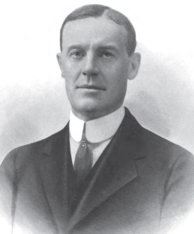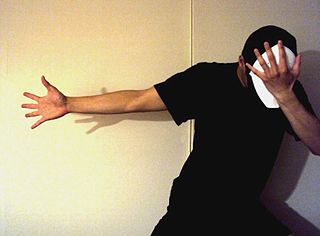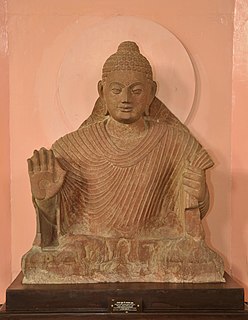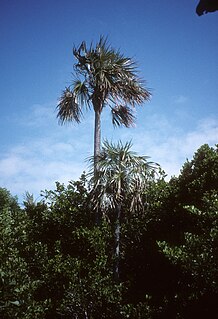Ḥeḥ was the personification of infinity or eternity in the Ogdoad in Egyptian mythology. His name originally meant "flood", referring to the watery chaos that the Egyptians believed existed before the creation of the world. The Egyptians envisioned this chaos as infinite, in contrast with the finite created world, so Heh personified this aspect of the primordial waters. Heh's female counterpart was known as Hauhet, which is simply the feminine form of his name.

The hooded oriole is a medium-sized New World oriole. The male of this species ranges in color from a bright orange to a paler yellow, with a black back, face, tail and bib, with the wing containing two white bars. The female is more of an olive color with some yellow accents.

A mudra is a symbolic or ritual gesture or pose in Hinduism, Jainism and Buddhism. While some mudras involve the entire body, most are performed with the hands and fingers.

George White was an American politician who served as the 52nd Governor of Ohio.

Mid-century modern (MCM) is an American design movement in interior, product, graphic design, architecture, and urban development that was popular from roughly 1945 to 1969, during the United States's post–World War II period. The term was used descriptively as early as the mid-1950s, and defined as a design movement by Cara Greenberg in her 1984 book, Mid-Century Modern: Furniture of the 1950s. It is now recognized by scholars and museums worldwide as a significant design movement. The MCM design aesthetic is modern in style and construction, aligned with the Modernism movement of the period. It is typically characterized by clean, simple lines, honest use of materials, and it generally does not include decorative embellishments.

Jazz hands in performance dance is the extension of a performer's hands with palms toward the audience and fingers splayed. This position is also referred to as webbing. It is commonly associated with especially exuberant types of performance such as musicals, cheerleading, show choir, revue, and especially jazz dance shows. In cheerleading, the position with arms outstretched and fingers wiggling up and down is sometimes referred to as spirit fingers or jazz fingers. Depending on the performance venue, both gestures can be associated with campiness.

The Abhayamudrā "gesture of fearlessness" is a mudrā (gesture) that is the gesture of reassurance and safety, which dispels fear and accords divine protection and bliss in many Indian religions. The right hand is held upright, and the palm is facing outwards. This is one of the earliest mudrās found depicted on a number of Hindu, Buddhist, Jain and Sikh images.

Coccothrinax is a genus of palms in the family Arecaceae. There are more than 50 species described in the genus, plus many synonyms and subspecies. A new species was described as recently as 2017. Many Coccothrinax produce thatch. In Spanish-speaking countries, guano is a common name applied to Coccothrinax palms. The species are native throughout the Caribbean, the Bahamas, extreme southern Florida and southeastern Mexico, but most of the species are known only from Cuba.

Arenga is a genus of palms, native to Southeast Asia, southern China, New Guinea, and northern Australia. They are small to medium-sized palms, growing to 2–20 m tall, with pinnate leaves 2–12 m long. Arenga palms can grow in areas with little sunlight and relatively infertile soil.

Brahea is a genus of palms in the family Arecaceae. They are commonly referred to as hesper palms and are endemic to Mexico and Central America. All Hesper Palms have large, fan-shaped leaves. The generic name honours Danish astronomer Tycho Brahe (1546-1601).

Attalea speciosa, the babassu, babassu palm, babaçu, or cusi, is a palm native to the Amazon Rainforest region in South America. The babassu palm is the predominant species in the Maranhão Babaçu forests of Maranhão and Piauí states.

Thrinax is a genus in the palm family, native to the Caribbean. It is closely related to the genera Coccothrinax, Hemithrinax and Zombia. Flowers are small, bisexual and are borne on small stalks.

Rodrigo Bernal González is a Colombian botanist who specialises in the palm family. Bernal was a faculty member at the Institute of Natural Sciences, National University of Colombia until 2007. He received his Ph.D. from the University of Aarhus, Denmark, in 1996. He was general curator of the National Colombian Herbarium (1986-1987), and editor of the scientific journal Caldasia.

Pseudophoenix sargentii, commonly known as the Florida cherry palm or buccaneer palm, is a medium-sized palm native to the northern Caribbean, eastern Mexico, and extreme southeast Atlantic Florida.

Mauritia is a genus of fan palms which is native to northern South America and to the Island of Trinidad in the Caribbean. Only two species are currently accepted.
Andrew James Henderson is a palm-systematist and Curator of the Institute of Systematic Botany at the New York Botanical Garden. He has authored taxonomic descriptions of 140 species, subspecies and varieties of plants, especially in the palm family

Acrocomia is a genus of palms which is native to the Neotropics, ranging from Mexico in the north, through Central America and the Caribbean, and through South America south to Argentina.

The Coryphoideae is one of five subfamilies in the palm family, Arecaceae. It contains all of the genera with palmate leaves, excepting Mauritia, Mauritiella and Lepidocaryum, all of subfamily Calamoideae, tribe Lepidocaryeae, subtribe Mauritiinae. However, all Coryphoid palm leaves have induplicate (V-shaped) leaf folds, while Calamoid palms have reduplicate leaf folds. Pinnate leaves do occur in Coryphoideae, in Phoenix, Arenga, Wallichia and bipinnate in Caryota.

John Shove "Bud" Palmer was an American professional basketball player. He was a member of the New York Knicks during the team's first three seasons in the Basketball Association of America, and was the leading scorer in the team's inaugural 1946–47 season. Palmer is considered to be one of the inventors of the jump shot.
The 1934 Princeton Tigers football team represented Princeton University in the 1934 college football season. The Tigers finished with a 7–1 record and outscored their opponents by a combined total of 280 to 38. Their sole loss was to Yale by a 7–0 score. No Princeton players were selected as first-team honorees on the 1934 College Football All-America Team.
















